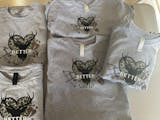Why Preparing Artwork for DTF Transfers Matters
Ever felt like your amazing designs don’t print the way you imagined? That’s because DTF (Direct-to-Film) printing has specific requirements to ensure your artwork looks crisp, vibrant, and professional on fabric.
By following DTF design guidelines, you can eliminate blurry prints, color inaccuracies, and unwanted distortions. This guide will walk you through the best file formats for DTF, resolution requirements, and expert design tips for flawless results.
Best File Formats for DTF Printing
Choosing the correct file format is essential for high-quality DTF transfers. Here are the best options:
- PNG (Preferred): Retains transparency and high image quality.
- PSD (Photoshop): Keeps all design layers intact for easy modifications.
- SVG: Great for vector designs but may require rasterization before printing.
Avoid using JPEG, as it compresses images and reduces quality.
Optimal Resolution for DTF Prints
For sharp, high-quality prints, follow these resolution guidelines for DTF printing:
- 300 DPI (dots per inch) - The industry standard for professional prints.
- 150 DPI (minimum acceptable quality) - Usable for large prints viewed from a distance.

Always design at the actual print size to maintain image clarity.
Key DTF Design Guidelines
Follow these essential DTF design tips*to achieve optimal print results:
- Design in RGB color mode for accurate color reproduction.
- Keep transparent backgrounds for cleaner edges.
- Ensure text and small details are at least 6pt font size for readability.
- Avoid low-opacity elements (below 75%), as they may not transfer well.
- Convert all text to outlines to avoid missing fonts or fonts changing during the printing process.
Common DTF Artwork Mistakes (and How to Avoid Them)
Even experienced designers make mistakes. Here’s what to watch out for:
| Common Mistake | How to Fix It |
|---|---|
| Using Low-Resolution Images | Design at 300 DPI to prevent pixelation. |
| Incorrect Color Mode | Always design in RGB to match printer settings. |
| Not Converting Text to Outlines | Convert text to outlines in Illustrator or Photoshop. |
| Saving in JPEG Format | Use PNG for the highest quality. |
Final Thoughts: Mastering DTF Design
By following these DTF design guidelines, you’ll ensure sharp, vibrant, and durable transfers that look professional on any garment.

Want to test your designs with DTF transfers? Order from We Print U Press and get premium-quality prints delivered to your door.








